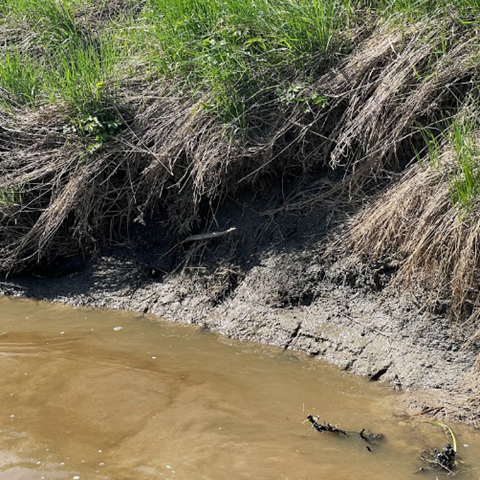Facts:
- Main subject area: Environmental Science
- Level and length: basic level (Bachelor, 15 hp / 10 weeks) or advanced level (Master, 30 hp / 20 weeks)
- Language: Swedish or English (for Master)

In this project, you will compare regular monitoring (grab samples) with in-situ sensor data to better quantify loads and trends in a stream in central Sweden.
To monitor the rapidly changing water in a stream is a well-known challenge. In national monitoring programs, we use monthly grab samples that are later analysed in the lab. These data miss a lot of the dynamics going on in between the samples and often lead to an underestimation of nutrient loads (for example phosphorus load to the Baltic Sea; Jones et al. 2012). High concentrations are often connected to specific processes in the environment, e.g. snowmelt or intense rainfall. When we miss them, it also makes it harder to evaluate the effects of mitigation measures (Sandström et al. 2023). The recent years, we have deployed in-situ sensors in a few streams, collecting data every 15th minute which makes it possible to follow rapid changes, e.g. connected to changes in flow. However, not all parameters can be monitored with high-frequency sensors, which is why turbidity is often used as a proxy for total phosphorus TP (Jones et al. 2012).
In Kilaån, close to Nyköping, a high-frequency sensor has been deployed since 2017. The ordinary monitoring program at this site is unusually frequent, with weakly grab sampling. Together with the sensor data, this dataset gives a unique possibility to compare monitoring with the sensor measurements and to explore new statistical methods for trend analysis (Figures below; Ottander 2020). In this study, the effect of sampling frequency will be explored to identify a cost-efficient combination of high-frequency monitoring data and grab sampling. The comparison will be done by using turbidity as a proxy for total phosphorus and calculating loads with different data sets. Further, novel statistical methods for detecting trends in extreme values (Olivetti and von Brömssen 2021) will be tested.
If you want to do a project which is directly relevant to decision-makers and authorities working with the monitoring of water and this sounds interesting, please contact Emma or Jens.
References
Jones A.S., Horsburgh J.S., Mesner N.O., Ryel R.J., Stevens D.K., 2012. Influence of sam- pling frequency on estimation of annual total phosphorus and total suspended solids loads. J. Am. Water Resour. Assoc. 48 (6), 1258–1275.
Olivetti L. & von Brömssen C., 2021, Modelling and Visualising Trends of Extreme Values in Acidifying Variables, Department of Energy and Technology Report 121(2021), SLU, Uppsala
Ottander N. Högfrekventa mätningar med sensorer för transportberäkning av totalfosfor i vattendrag (2020). Master thesis, Uppsala universitet, Uppsala
Sandström S., Lannergård E.E., Futter M.N., Djodjic F. 2024. Water quality in a large complex catchment: Significant effects of land use and soil type but limited ability to detect trends. Journal of Environmental Management. 349:119500.